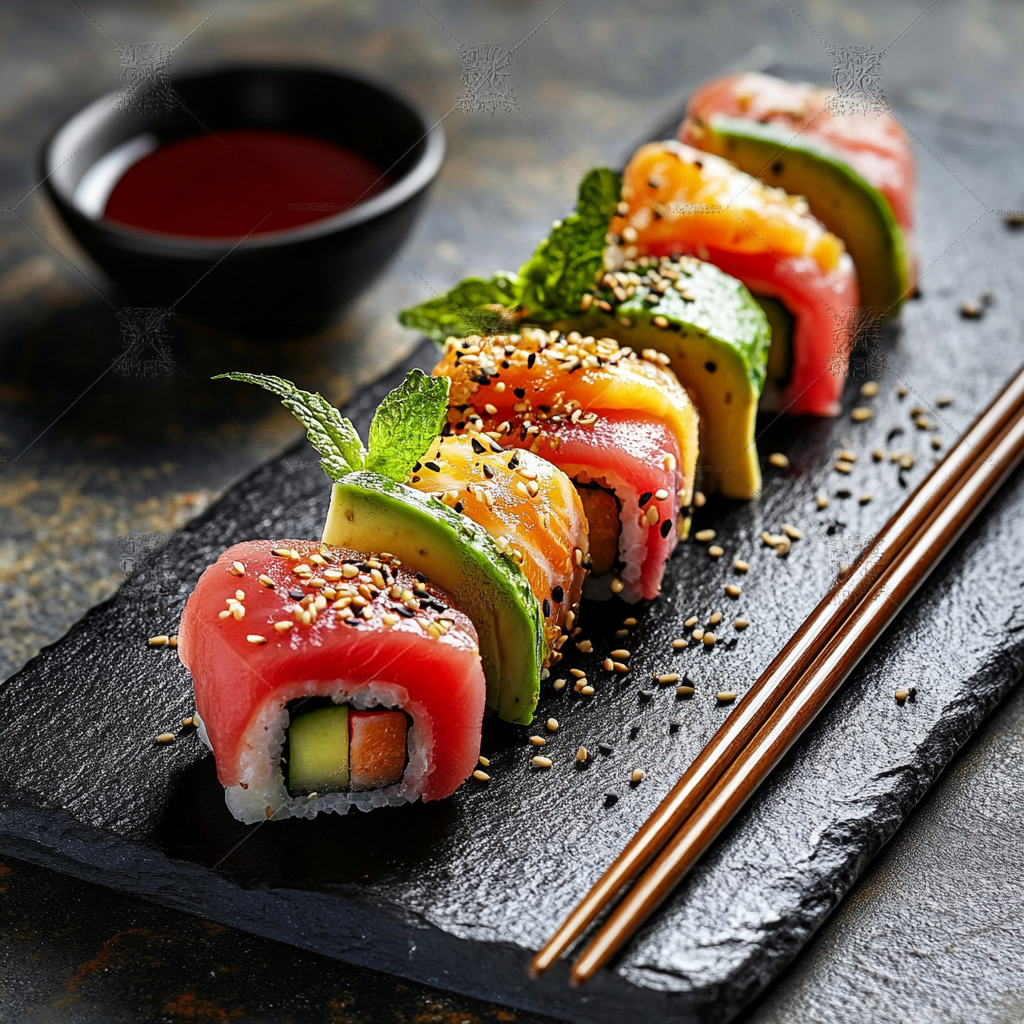Introduction to Sushi Delights
Sushi is more than just a meal; it’s an art form that has captivated food lovers across the globe. Combining fresh, high-quality ingredients with meticulous preparation, sushi offers a dining experience that is as visually stunning as it is flavorful. Whether you prefer the simplicity of a nigiri or the complexity of a specialty roll, sushi delights come in countless variations to satisfy every palate.

Why Sushi is a Global Culinary Phenomenon
Sushi’s global appeal lies in its ability to bridge tradition and modernity. First, it showcases the Japanese philosophy of balance and precision, which resonates with food enthusiasts worldwide. Moreover, sushi’s adaptability allows chefs to experiment with unique ingredients, making it a versatile and ever-evolving cuisine. Finally, its health benefits, thanks to fresh fish, seaweed, and rice, have further cemented its status as a beloved culinary experience.
The Evolution of Sushi from Tradition to Innovation
Sushi originated centuries ago in Japan as a method of preserving fish with fermented rice. Over time, it evolved into an elegant cuisine, featuring fresh ingredients and artistic presentation. Today, sushi chefs worldwide are redefining tradition by incorporating innovative techniques and unexpected flavors, creating exciting dishes that maintain their cultural roots.
What Makes a Dish a Popular Sushi Delight?
A sushi dish becomes a popular delight when it achieves the perfect harmony of flavor, texture, and presentation. The combination of fresh seafood, seasoned rice, and complementary toppings or sauces creates a symphony of tastes. Additionally, attention to detail in the rolling, cutting, and plating process ensures every bite is a work of art.
Essential Ingredients for Sushi
Creating sushi at home requires attention to detail and the right ingredients. Each component contributes to the balance of flavor, texture, and presentation that makes sushi a culinary masterpiece. From perfectly cooked rice to fresh fish and flavorful condiments, every ingredient plays a crucial role.
The Basics for Perfect Sushi
Achieving authentic sushi starts with mastering its foundational ingredients.
Selecting the Right Sushi Rice
- Why It’s Important: Sushi rice is the backbone of every sushi dish. Its sticky texture and slightly sweet, tangy flavor hold the rolls together and enhance the overall taste.
- Tips: Use short-grain rice and season it with a mixture of rice vinegar, sugar, and salt to achieve the classic sushi rice flavor.
The Importance of High-Quality Fish
- Freshness Is Key: Sushi-grade fish ensures safety and a delicate flavor. Look for fish labeled as “sushi-grade” or purchase from a trusted fishmonger.
- Popular Choices: Tuna, salmon, yellowtail, and shrimp are some of the most common options for sushi.
Nori (Seaweed): Choosing the Best Sheets
- Quality Matters: High-quality nori sheets are dark, shiny, and have a crisp texture. They provide structural integrity and a hint of umami flavor.
- Tip: Toast the nori lightly before use to enhance its flavor and texture.
Essential Condiments: Soy Sauce, Wasabi, and Pickled Ginger
- Soy Sauce: Adds a salty, umami kick to balance the sushi flavors.
- Wasabi: A spicy paste that enhances the fish’s taste.
- Pickled Ginger: Cleanses the palate between bites, allowing you to fully enjoy each piece of sushi.
Tools of the Trade
The right tools are as important as the ingredients for crafting perfect sushi rolls.
Bamboo Mat (Makisu) for Rolling
- Why You Need It: A bamboo mat helps roll sushi evenly and securely.
- Tip: Wrap the mat in plastic wrap to prevent rice from sticking and make cleanup easier.
Sharp Knife for Precision Cuts
- Importance of a Sharp Blade: A sharp knife ensures clean, precise cuts that preserve the integrity of the sushi roll.
- Tip: Dip the blade in water before cutting to prevent sticking and achieve smoother slices.
By combining these essential ingredients and tools, you can create sushi that rivals your favorite restaurant’s offerings. The key is to focus on quality, balance, and technique, ensuring every bite is a delight.
For an authentic experience, try using homemade flatbreads like in this Cottage Cheese Flatbread Recipe as an unconventional wrap for fusion sushi rolls.
Step-by-Step Guide to Making Sushi Delights
Mastering sushi at home is a rewarding experience that combines precision, creativity, and fresh ingredients. Follow this step-by-step guide to create restaurant-quality sushi delights, from preparing perfect rice to assembling and plating your rolls.

Preparing the Rice: Achieving Perfect Consistency
Sushi rice is the foundation of great sushi, and achieving the right texture and flavor is essential.
Washing and Cooking Sushi Rice
- Washing: Rinse the rice several times under cold water until the water runs clear. This removes excess starch and prevents clumping during cooking.
- Cooking: Use a rice cooker or stovetop method with a 1:1.2 rice-to-water ratio. Cover tightly while cooking and let it rest for 10 minutes after removing it from the heat.
Seasoning the Rice with Vinegar Mixture
- Preparation: Mix rice vinegar, sugar, and salt in a small saucepan. Heat gently until the sugar and salt dissolve, but avoid boiling.
- Mixing: Transfer cooked rice to a wide, shallow bowl. Slowly fold in the vinegar mixture with a wooden spoon, being careful not to mash the rice. Let it cool to room temperature before use.
Assembling Your Sushi
With your rice prepared, it’s time to assemble your sushi rolls.
Placing and Layering Ingredients
- Preparation: Lay a sheet of nori shiny side down on a bamboo mat. Spread an even layer of rice over the nori, leaving about 1 inch of space at the top edge.
- Adding Ingredients: Arrange your fillings—such as sliced fish, cucumber, avocado, or crab—horizontally across the center of the rice.
Rolling Techniques for Maki and Uramaki
- Maki Rolls: Use the bamboo mat to roll the nori tightly around the ingredients, starting from the bottom edge. Press firmly but gently to create a compact roll.
- Uramaki (Inside-Out Rolls): Place a sheet of plastic wrap on the bamboo mat and spread rice directly onto it. Flip the rice layer over, add fillings to the nori side, and roll as you would for maki.
Cutting and Plating for Aesthetic Appeal
- Cutting: Use a sharp knife dipped in water to slice the roll into even pieces. Clean the blade between cuts to maintain clean edges.
- Plating: Arrange sushi on a plate with attention to color and symmetry. Garnish with pickled ginger, wasabi, or sesame seeds for visual appeal.
Tips for Success
A few practical tips can make the sushi-making process smoother and more enjoyable.
Maintaining Clean Hands for Rolling
- Keep Hands Wet: Dip your hands in a bowl of water mixed with a little rice vinegar to prevent rice from sticking to your fingers while handling it.
Avoiding Overfilling Rolls
- Use Moderation: Avoid adding too much filling, as this can make rolling difficult and cause the sushi to fall apart.
Popular Variations of Sushi Delights
Sushi has evolved into a global culinary art form with endless variations to suit every palate. From traditional classics to innovative modern creations, each roll offers a unique combination of flavors and textures. Here’s a look at some popular variations of sushi delights.
Classic Sushi Rolls
The foundation of sushi culture lies in these timeless rolls that have won over food enthusiasts worldwide.
California Roll
- Ingredients: Imitation crab, cucumber, and avocado wrapped in rice and nori, often topped with sesame seeds or tobiko.
- Why It’s Popular: This roll’s mild flavors and creamy texture make it a perfect introduction to sushi for beginners.
Spicy Tuna Roll
- Ingredients: Fresh tuna mixed with spicy mayo, rolled with rice and nori.
- Why It’s Popular: The heat from the spicy mayo adds a bold kick, balanced by the coolness of the rice.
Philadelphia Roll
- Ingredients: Cream cheese, smoked salmon, and cucumber wrapped in rice and nori.
- Why It’s Popular: The creamy richness of cream cheese pairs beautifully with the savory smokiness of salmon.
Creative Modern Rolls
These innovative rolls showcase the creative possibilities of sushi, blending traditional techniques with bold flavors.

Dragon Roll
- Ingredients: Tempura shrimp and cucumber inside, topped with avocado slices and drizzled with eel sauce.
- Why It’s Popular: Its eye-catching presentation and mix of crunchy and creamy textures make it a standout dish.
Rainbow Roll
- Ingredients: A California roll base topped with slices of fresh fish like tuna, salmon, and yellowtail, along with avocado.
- Why It’s Popular: The colorful topping not only looks stunning but also provides a variety of fresh, bold flavors in every bite.
Fusion Sushi with Unique Fillings
- Examples: Rolls with unconventional ingredients such as mango, cream cheese, or spicy sriracha aioli.
- Why It’s Popular: These rolls appeal to adventurous eaters looking to explore sushi beyond traditional fillings.
Serving Sushi Delights
Sushi delights are best enjoyed with thoughtfully chosen accompaniments that enhance their flavors and complete the dining experience. From complementary side dishes to perfectly paired beverages, here’s how to serve sushi like a pro.
Pairing Sushi with Complementary Dishes
The right side dishes add balance and variety to your sushi meal, elevating it from delicious to unforgettable.
Miso Soup and Edamame
- Miso Soup: A warm bowl of miso soup, with its savory umami flavor, is a traditional starter that cleanses the palate and sets the tone for the sushi experience.
- Edamame: Lightly salted steamed edamame provides a healthy, protein-packed snack that pairs perfectly with the fresh flavors of sushi.
Tempura as a Side Dish
- Why It’s Popular: Lightly battered and fried vegetables or shrimp add a delightful crunch to the meal, offering a textural contrast to the soft sushi rolls.
- Serving Tip: Serve tempura with a light dipping sauce to complement the sushi without overpowering it.
Beverage Pairings
Pair your sushi with beverages that enhance the delicate flavors of the dish, creating a harmonious dining experience.
Sake and Green Tea
- Sake: This traditional Japanese rice wine pairs beautifully with sushi, as its mild sweetness complements the umami of fish and soy sauce.
- Green Tea: A cup of hot green tea cleanses the palate and enhances the overall freshness of the meal.
Modern Options: Wine or Beer
- Wine: A crisp white wine like Sauvignon Blanc or Riesling pairs well with the light, fresh flavors of sushi.
- Beer: Japanese lagers like Asahi or Sapporo offer a clean, refreshing contrast to sushi’s richness, while craft beers provide a bold, modern pairing.
Storage and Leftover Tips
Properly storing and repurposing sushi leftovers ensures that none of your delicious sushi goes to waste. With these tips, you can safely store and creatively enjoy sushi even after the meal is over.
Storing Sushi Safely
When it comes to sushi, freshness is key. Proper storage methods are essential to maintaining both safety and taste.
How Long Can Sushi Be Kept?
- Time Frame: Sushi made with raw fish should be consumed within 24 hours if stored properly in the refrigerator.
- Cooked Sushi: Rolls made with cooked ingredients, such as tempura shrimp or cooked crab, can last up to 48 hours.
- Important Note: Always check for changes in smell or texture before consuming leftovers.
Best Practices for Refrigerating Leftovers
- Wrap Tightly: Store leftover sushi in an airtight container or wrap it tightly in plastic wrap to prevent drying out.
- Temperature: Keep sushi in the coldest part of the refrigerator (around 40°F or below) to ensure safety.
- Separate Sauces: Avoid refrigerating soy sauce or wasabi with sushi to maintain the freshness of the rolls.
Reheating and Repurposing Leftovers
Leftover sushi can still be delicious when repurposed or reheated carefully.
Making a Sushi Bowl from Leftovers
- How to Transform It: Deconstruct leftover rolls by placing the rice and fillings into a bowl. Add fresh toppings like sliced avocado, cucumber, or a fried egg for a quick sushi-inspired meal.
- Optional Dressings: Drizzle with soy sauce, spicy mayo, or sesame oil to enhance the flavors.
Refreshing Sushi Rice
- Rehydration Tip: Lightly sprinkle the sushi rice with a few drops of water and cover it with a damp paper towel. Microwave for 20–30 seconds to restore its softness.
- Serve Warm: This method works best for rolls with cooked ingredients, as raw fish should not be reheated.
The Japanese Food Guide – Explore more traditional Japanese recipes and ingredients.
Frequently Asked Questions (FAQs)
Here are answers to common questions about sushi preparation, designed to help you master the art of sushi-making and customize it to your preferences.
Common Queries About Sushi Preparation
Can I Use Regular Rice Instead of Sushi Rice?
- Technically Yes, But Not Ideal: Regular rice lacks the sticky texture needed for proper sushi rolls. For the best results, use short-grain sushi rice, which holds together better and provides the authentic flavor.
- Tip: If you must use regular rice, add a bit of extra water during cooking and mix it with sushi vinegar to mimic the texture.
How Do I Handle Raw Fish Safely?
- Choose Sushi-Grade Fish: Always buy fish labeled “sushi-grade” or “sashimi-grade” from a reputable source to ensure safety.
- Storage: Keep raw fish cold at all times, ideally below 40°F, and consume it within 24 hours.
- Preparation: Use clean utensils and surfaces to prevent cross-contamination.
What’s the Best Way to Roll Sushi Without a Mat?
- Plastic Wrap Technique: Lay a sheet of plastic wrap on a flat surface, place the nori and rice on top, and use the wrap to roll the sushi tightly.
- Alternative Tools: A clean kitchen towel can also act as a substitute for a bamboo mat, providing the necessary flexibility for rolling.
Are There Vegan Sushi Options?
- Absolutely: Popular vegan sushi options include rolls filled with avocado, cucumber, pickled vegetables, tofu, or sweet potato tempura.
- Toppings: Consider garnishing with sesame seeds, vegan spicy mayo, or sriracha for added flavor.
Can Sushi Be Made Without Nori?
- Yes, It Can: Instead of nori, you can use soy paper, rice paper, or thinly sliced cucumber to wrap your sushi.
- Creative Alternatives: If rolling isn’t your style, make a sushi bowl by layering rice, toppings, and sauces in a bowl for an easy, nori-free option
Conclusion: Why Sushi Delights Are the Perfect Fusion of Art and Flavor
Sushi delights are more than just food—they are a celebration of culinary artistry and diverse flavors. Each roll combines fresh, high-quality ingredients with precise techniques, resulting in a harmonious balance of taste, texture, and presentation. Moreover, sushi seamlessly blends tradition with innovation, making it a global phenomenon that caters to both purists and adventurous foodies alike.
Whether you’re enjoying a classic California roll or exploring bold fusion creations, sushi offers an experience that engages all the senses. Ultimately, its versatility, creativity, and health benefits make it the perfect fusion of art and flavor for any occasion.






